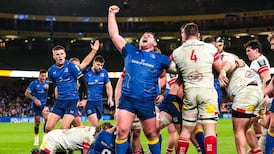So Leinster's superb win last Friday put paid to my musings regarding playing Josh van der Flier against France.
Mind you, van der Flier could be replaced by Dan Leavy as the younger man has even more of the purest openside in him. He could add value tomorrow in breakdowns and turnover ball.
I came across ‘French Rugby 1980s to Present’ on Youtube yesterday. It’s pure quality.
The opening shot was of my first openside hero, Jean-Pierre Rives, against England in 1983. Would he make it today?
Next up was Laurent Cabannes against Ireland in 1991. Now there was an openside. What Paco and Gaillimh were doing as Cabannes scored I'm not sure, but in 1995 he was back.
By 2010 the French were still scoring but they were considerably bigger as Mathieu Bastareaud et al had arrived and the subtlety that Rives had in spades was lost – they've changed.
So what are France transitioning towards?
Well, they’ve a discernible structure akin to Connacht, spreading their resources in independent forward pods, 1-3-3-1, and I’ve always noted where a team invest in strength there will be weaknesses elsewhere.
So ignoring Louis Picamoles and Gael Fickou's quality, and a possible set piece parity, I'll focus on looking at French turnovers.
With so many 50-50 French passes and especially their vulnerable breakdown (due to poor body positions in offload hunting) Ireland need a simple plan to win turnovers and expose the French fatties when those precious steals arrive (10 against England; eight against Scotland but more from frees, penalty and set piece loss).
Think of Scotland's Stuart Hogg running a poor Irish clearance kick last year in Dublin as he tore through the Irish forwards languishing in midfield – no accident.
The best steal/turnover is off a lineout but breakdown steals are more valuable in destroying the opposition’s attack mentally.
Evolving play
They are all about technique. The ability to allow the heavy wash of opposition slide over you as you hunt for the ball, especially with two French players aiming for the Irish jackal, a nanosecond is all he’ll get.
One component is crucial – the ability to read the evolving play as the French look to offload. Leavy is superb at this and gets his body position and feet in place long before the window opens. So Seán O’Brien must sacrifice some ball carrying to gain time, read the French and then create turnovers that will punish French defensive decision-making.
The new French pod system has limitations. Firstly in attack, where a line break occurs, there can often be a loss of follow up as resources are spread across the field.
This is where Cabannes could wreak havoc with his instinct to watch potential evolve. But if he’s 50 metres away he can’t impact. Also in defence, and especially from a turnover, the French will have to reshuffle very quickly to hide 145kg tight head Uini Atonio (when he comes on) and others from being exposed should Ireland so choose.
Here is where I feel Ireland need their greatest evolution. What to do when quality opposition give the ball away?
Pity sevens player Virimi Vakatawa is out as he doesn't have the corporate knowledge of the multitude of defensive scenarios required. Impressive winger Yoann Huget's arrival bumps Noa Nakaitaci to the other wing and Ireland need therefore to force Nakaitaci into making uncomfortable decisions, not from first phase but fifth and sixth.
Only then will he be in no-man's land. Equally, broken field turnover ball offers Ireland the best way of getting him to make uncomfortable decisions. Should Rob Kearney receive deep in his half and simply run into heavy traffic, Nakaitaci will hide away on his wing. Should Kearney start a chain effect on his counter attack then France may be exposed.
Narrow face
I fancy our overall game knowledge and fitness to execute is superior, however, I do expect a subtler performance from Jack McGrath in managing
Rabah Slimani
.
Even with France’s improvements in their lineout maul, the Irish are better tuned so should go to touch off penalties if they continue to elongate their maul. French physique is so big that they have grown lazy in their technique, electing to batter from all sides in an individual attack. Should the Irish give a narrow face to the maul then further French penalties will arrive.
A word of warning – if we maintain our insistence on one out carries by our brave big men as we did in Paris last year then the French will happily bully backwards. Attacking the heart of the French defence may have an opposite effect to our intentions, to embolden them rather than dissuade.
So like in Rome, tip-on passes, George Gregan’s, offloads, changes of angles and especially a quality counterattack is needed to expose a French side that think they are improving. But are far from the Jean-Pierre Rives era.
Finally, I get the selection this week and totally understand the value of Iain Henderson and Peter O’Mahony in the closing quarter.
With Uini Atonio on the bench, when Joe Schmidt introduces his replacement front row it will be crucial in scrum and broken field. Target Atonio everywhere for his 20 minutes, it's worth it!
I’m still at odds with the back three and I suppose the balance between so many factors are at play. But counterattack is not simply a case of fielding from deep and running ball into heavy traffic. The sweetest of passes can unlock even the deftest of defences, where the likes of Atonio and Nakaitaci could be left in the wind.
liamtoland@yahoo.com











